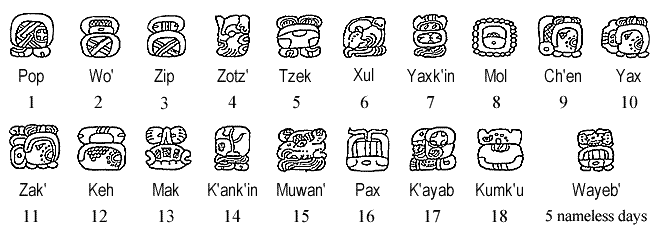HAAB CALENDAR - 365 DAY MAYAN SOLAR CALENDAR

HAAB' CALENDAR: 360 DAYS AND WAYEB' (5 DAY) MAYAN CALENDAR CYCLE
The Haab calendar (also spelled "Haab'" in modern Yucatec Maya) is considered to be the rough equivalent to our modern 365 day Gregorian calendar with both being attune to the Sun and our planet's changing of the seasons observed in a solar year. As it was with the 260 day Tzolkin sacred cycle, the 365 day cycle of the Haab (also called the Mayan "Vague Year") was common to many Mesoamerican cultures, such as the Aztecs who called it their "Xiuhpohualli".
It is generally acknowledged by archeologists and many in science that the eariest known solar calendars used by humans were those devised by the ancient Mayans and Egyptians. [6, p.23] The most commonly accepted speculation for initial usage of the Haab calendar is given by Victoria Bricker, Ph.D., who estimates that it first occurred sometime around the winter solstice of 550 B.C. [32, pp. 101-103]
Whereas, our Gregorian calendar first implemented by Pope Gregory XIII in 1582 A.D. figures the solar year at 365.2425 days (a correction of the Julian calendar figure of 365.25 days), the ancient Maya had calculated their Haab calendar's solar year to be more accurate at 365.2422 days. The great irony here being, it was the combined powers of the Roman Catholic Church authority and the Spanish monarchy who had waged a war of cultural genocide against the natives of Mesoamerica for being the suspect of inferiority; when in fact, many of their mindsets and understandings were centuries ahead of the 16th Century Europeans. Likewise, while our modern world continues to use the calculations of Papal Rome, as of January 1, 2000, our best trained astronomers recently recorded the mean tropical year at 365.2421897 days, which has now put us on par with what the ancient Mayans had already known. [11, p.40-42]
There are two main components which make up the Haab calendar. The first consists of an 18 month period of 360 days called a "Tun". The second is an ending period of 5 nameless days called the "Wayeb" (also spelled "Uayeb"). Each of the 18 months are known as a "Winal" (also spelled "Uinal"). Unlike our modern calendar, the Mayan months do not vary in length with each consisting of an even 20 days (20 k'in). See doc: "Time Periods of the Mayan Calendar System"

While the first 18 months of 20 day periods creating the Tun were considered to be normal and productive days, the succeeding 5 nameless days of the Wayeb were a period of traditional ritualistic practice. Far too often, it is stated by Western scholars that the 5 ending days of the Wayeb were considered to be 'unlucky' by the ancient Mayans. This of course is a grand and somewhat depreciating external speculation, which can also unfortunately lead toward an assumption and stigma of mere superstition alone. The better words to apply would be that they considered the end of their Haab calendar cycle to be rather mathematically 'important' and/or spiritually 'significant'. What is known for sure is that the end of their 365 day calendar year was a time used for the observation of fasting and sacrifice to the Mayan gods. Thus, most of the time spent on activities during the Wayeb focused on preparation for the new Haab calendar cycle with specific sunrise & sunset fire ceremonies, and sacred ritual purifications being performed. It is therefore highly conjectured that the Wayeb was used as a time for deep reflection on one's present blessings and anticipation of the new cycle, i.e., Mayan New Year.
Like all solar calendars of every advanced civilization that has come to develop one, there are certain basic similarities; such as, a need to keep track of the seasons for agriculture, and one perplexing problem which has always existed through the ages. Because the actual length of time it takes for our Sun to re-appear in its exact same positions as seen from Earth is slightly longer than 365 days, periodic adjustments are needed to keep an accumulation of the yearly calendar counts in alignment with the Earth's true revolutions around the Sun. The ancient Mayans approached this problem differently than what we do today. Instead of adding a leap year every 4 years, they subtracted 13 days every 52 years. The Haab calendar has an error of only 1 day in 6729 years, while our modern calendar has an error of just 1 day in 3236 years. ( article by: Angel Tenez, 2009 )

